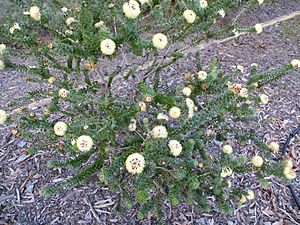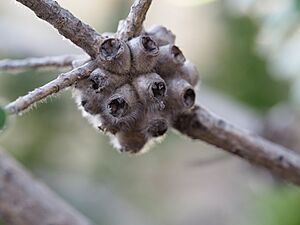Melaleuca megacephala facts for kids
Quick facts for kids Melaleuca megacephala |
|
|---|---|
 |
|
| Melaleuca megacephala (cultivated) | |
| Scientific classification | |
| Genus: |
Melaleuca
|
| Species: |
megacephala
|
Melaleuca megacephala is a special plant from the myrtle family. It grows naturally in the south-west part of Western Australia. You can spot it by its big, round heads of yellow and white flowers. These flowers grow at the ends of its branches. It also has brown, overlapping leaf-like parts called bracts right under the flowers.
Contents
About the Plant
Melaleuca megacephala is a tall, bushy shrub. It has rough bark and branches that can break easily. This plant can grow up to 3 meters (about 10 feet) tall. It can also spread out to about 0.6 meters (about 2 feet) wide.
Its leaves are arranged one after another on the stems. They are oval-shaped and slightly curved. Each leaf is about 5.5 to 20.5 millimeters (0.2 to 0.8 inches) long. They are also about 3.5 to 10.5 millimeters (0.1 to 0.4 inches) wide. The leaves have 3 to 5 lines running along them.
The flowers grow in round heads, mostly at the tips of the branches. The branches keep growing even after the flowers bloom. Thin, papery brown bracts wrap around the flower buds. They stay there even when the flowers open. The tiny threads inside the flowers are white. These are called filaments. The yellow or cream-colored tips on these threads are called anthers. This makes the flowers look pale yellow.
Each flower head has 4 to 12 groups of flowers, with three flowers in each group. The heads can be up to 50 millimeters (about 2 inches) wide. The petals are about 3 to 5 millimeters (0.1 to 0.2 inches) long. They fall off as the flower gets older. The stamens are grouped into five bundles around the flower. Each bundle usually has 12 to 16 stamens.
This plant usually flowers from June to November. But it blooms most often in early spring. After flowering, it produces woody, cup-shaped fruits. These fruits are called capsules. They are about 4.5 to 7 millimeters (0.2 to 0.3 inches) long. These capsules grow in clusters along the stem.
How It Got Its Name
The plant Melaleuca megacephala was first officially described in 1862. This was done by Ferdinand von Mueller. He wrote about it in his book "Fragmenta phytographiae Australiae".
The second part of its name, megacephala, comes from Ancient Greek words. Mégas means "large" or "great." Kephalḗ means "head." So, the name refers to the plant's large flower heads.
Where It Grows
This melaleuca plant is found in the Geraldton and Kalbarri areas. These areas are in Western Australia. It grows in sandy soil on flat sand plains. It can also be found on rocky hills.
Looking After the Plant
The Government of Western Australia says this plant is "not threatened." This means it is not in danger of disappearing.
Growing in Gardens
This plant is not very common in gardens. However, people have known about it for a long time. It grows well in soil that drains water easily. If you trim it carefully, it will produce many beautiful flowers the next season.
Plant Oils
The leaves of M. megacephala contain special natural oils. These oils are called monoterpenes and sesquiterpenes.
Images for kids




